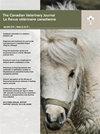疑似猪病原体的气溶胶传播:一个实地案例。
IF 0.9
4区 农林科学
Q3 VETERINARY SCIENCES
Canadian Veterinary Journal-revue Veterinaire Canadienne
Pub Date : 2024-07-01
引用次数: 0
摘要
一个养猪生产系统有三个区,相距几公里。A 区和 C 区有几千头母猪、保育猪和育成猪。B 区位于其他两个区之间,规模最小,有 6 个育成场和 2 个母猪场。整个系统都感染了猪繁殖与呼吸综合征病毒、肺炎支原体和胸膜肺炎放线杆菌。B 区被清除、清洗、消毒,并重新饲养了阴性后备母猪。尽管采取了极端措施,但每种病原体都发生了再污染,气溶胶被认为是最可能的污染源。本文章由计算机程序翻译,如有差异,请以英文原文为准。
Suspected aerosol transmission of swine pathogens: A field case.
A swine production system had 3 sections located a few kilometers apart. Sections A and C contained several thousand sows and nursery and finishing pigs. Section B, located between the other 2 sections, was the smallest and had 6 finishing sites and 2 sow sites. The entire system was infected with porcine reproductive and respiratory syndrome virus, Mycoplasma hyopneumoniae, and Actinobacillus pleuropneumoniae. Section B was depopulated, cleaned, disinfected, and repopulated with negative gilts. Despite extreme measures, recontamination occurred for each pathogen, with aerosol considered the most plausible contamination source.
求助全文
通过发布文献求助,成功后即可免费获取论文全文。
去求助
来源期刊
CiteScore
1.20
自引率
10.00%
发文量
177
审稿时长
12-24 weeks
期刊介绍:
The Canadian Veterinary Journal (CVJ) provides a forum for the discussion of all matters relevant to the veterinary profession. The mission of the Journal is to educate by informing readers of progress in clinical veterinary medicine, clinical veterinary research, and related fields of endeavor. The key objective of The CVJ is to promote the art and science of veterinary medicine and the betterment of animal health.
A report suggesting that animals have been unnecessarily subjected to adverse, stressful, or harsh conditions or treatments will not be processed for publication. Experimental studies using animals will only be considered for publication if the studies have been approved by an institutional animal care committee, or equivalent, and the guidelines of the Canadian Council on Animal Care, or equivalent, have been followed by the author(s).

 求助内容:
求助内容: 应助结果提醒方式:
应助结果提醒方式:


